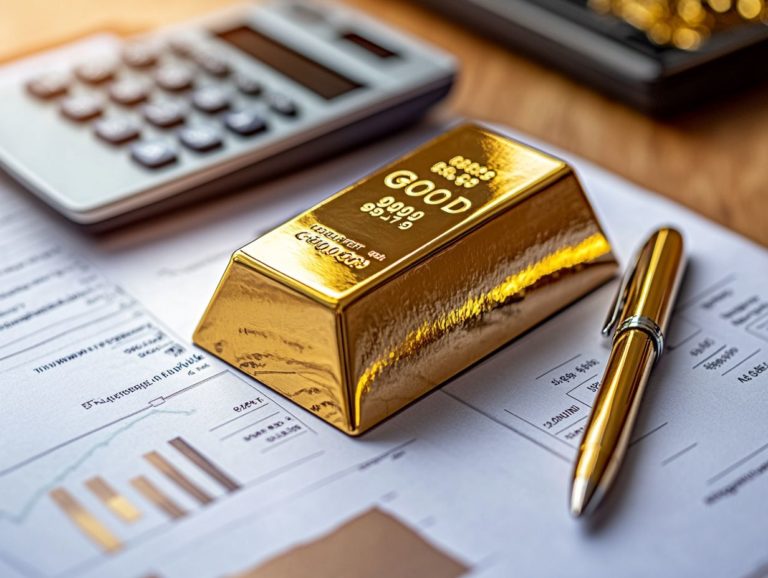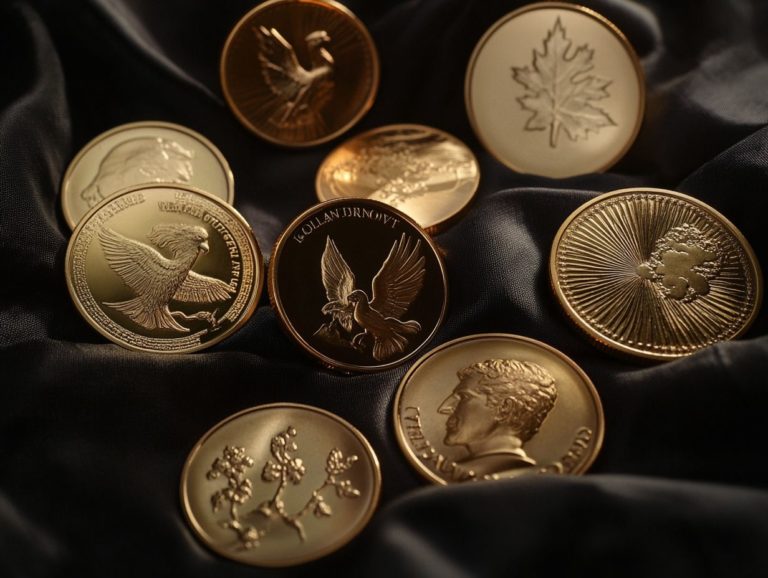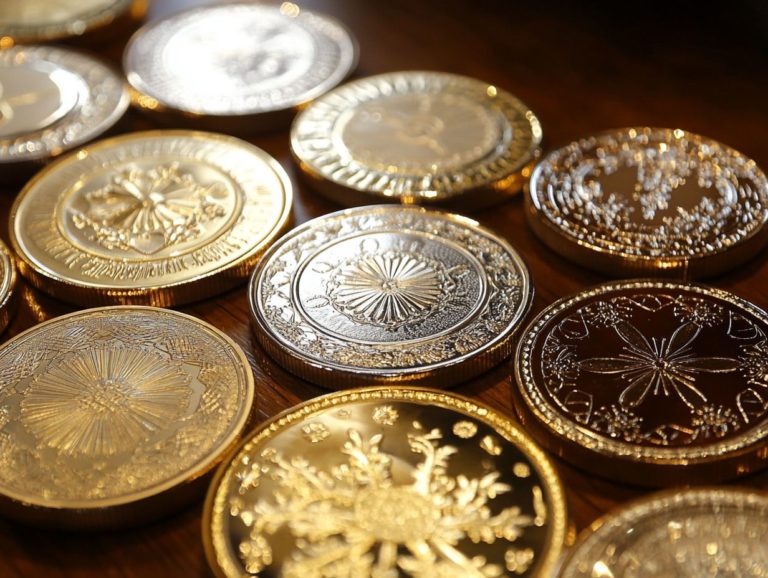How to Prepare for a Precious Metals Market Crash?
Curious about how to thrive in the precious metals market during tough times? You’re in the right place! Navigating the world of precious metals can be rewarding yet challenging, particularly during market downturns. Understanding the factors that trigger these crashes is essential for any savvy investor.
This article delves into the signs that may indicate a potential crash, effective strategies for spreading out your investments, and how to seize buying opportunities when times are tough.
It also examines the benefits of long-term investing compared to short-term trading and emphasizes the value of seeking professional advice. Equip yourself with the insights needed to confidently navigate market ups and downs.
Contents
- Key Takeaways:
- Understanding Precious Metals Market Crashes
- Signs of a Potential Market Crash
- Preparing for a Precious Metals Market Crash
- Strategies for Surviving a Market Crash
- Long-Term Investing vs. Short-Term Trading
- Seeking Professional Advice
- Frequently Asked Questions
- What is a precious metals market crash and why should I be concerned?
- What are some signs that a precious metals market crash may be approaching?
- How can I prepare for a precious metals market crash?
- What should I do if a precious metals market crash occurs?
- Should I consider buying or selling precious metals before a potential market crash?
- Do I need to worry about a precious metals market crash if I don’t own any precious metals?
Key Takeaways:
- Understand the causes of precious metals market crashes to better prepare for potential downturns.
- Keep an eye out for warning signs and utilize market indicators to stay informed about potential market crashes.
- Diversify your investments and have a solid plan in place to help minimize the impact of a precious metals market crash.
Understanding Precious Metals Market Crashes
Understanding the intricacies of precious metals market crashes is essential for both seasoned investors and newcomers seeking financial stability. A market crash can cause dramatic swings in gold and silver prices, often leading to an economic downturn that affects investor sentiment and strategies.
By recognizing how these fluctuations influence the value of precious metals, you gain valuable insights into effective asset diversification. Understanding the tax reporting for precious metals investments is crucial for this analysis, equipping you to navigate potential market volatility with confidence.
What Causes Market Crashes?
Market crashes can arise from a multitude of factors, including economic downturns, inflation anxieties, and shifts in investor sentiment that often spark widespread panic selling. Systemic financial risks also play a role, such as a faltering banking sector or a spike in debt defaults.
For instance, a sudden drop in critical economic indicators like rising unemployment rates or waning consumer confidence can alert investors to an impending downturn. Geopolitical events, whether conflicts or significant policy changes, frequently heighten uncertainty, causing even the most steadfast investors to reconsider their strategies.
Grasping these complex interconnections is vital for making informed investment decisions. They can trigger a domino effect, altering market dynamics and leading to a swift sell-off as participants rush to safeguard their assets.
Signs of a Potential Market Crash
Spotting the signs quickly could save you money. Recognizing the signs of a potential market crash is crucial for protecting your assets and sustaining financial stability in an unpredictable economic landscape. Indicators like soaring inflation, faltering stock performance, and heightened market volatility often serve as red flags for an impending downturn.
By remaining vigilant and informed about these warning signs, you can take proactive measures to hedge your bets. This strategic foresight is essential for preserving your wealth during challenging times.
Indicators to Watch for
When preparing for a potential market crash, keep a keen eye on several economic indicators:
- GDP growth rates
- unemployment statistics
- consumer spending trends
These metrics act as critical barometers for gauging the overall health of the economy, significantly impacting your investment decisions. For example, if you notice a decline in GDP growth, it could signal a weakening economy, prompting you to reassess your risk tolerance.
Consumer spending trends are equally telling; a decrease in spending often hints at underlying economic troubles. By meticulously analyzing these indicators, you can position yourself more effectively in the market. Additionally, understanding the impact of global tax policies on precious metals investing can also inform your strategies. Take action now! Review your investments and stay ahead of the curve.
Preparing for a Precious Metals Market Crash
Preparing for a potential crash in the precious metals market requires a thoughtful approach and the strategic implementation of effective ways to spread your investments that can protect your portfolio during economic downturns. By prioritizing safe-haven assets like gold and silver, you can safeguard your wealth and maintain financial stability amidst market turbulence.
It’s essential to stay aware of the risks associated with a liquidity crisis. Incorporating instruments such as Treasury bonds or cash equivalents into your investment strategy can significantly enhance the resilience of your portfolio. Additionally, understanding how to prepare for tax season as a precious metals investor can further strengthen your financial strategy. The secret lies in proactively managing risk and crafting a robust plan that addresses market volatility while optimizing your investment opportunities.
Diversifying Your Portfolio
Diversifying your portfolio is an essential strategy to mitigate the risks associated with market crashes, particularly in the world of investing in precious metals.
By incorporating a variety of asset classes, you can build a more resilient financial foundation. For example, adding dividend stocks not only presents a potential income stream but also offers opportunities for capital appreciation.
Corporate bonds can serve as a stabilizing force, acting as a buffer against the fluctuations often seen in equity markets. Real estate investments provide potential rental income and long-term value appreciation, further strengthening your overall portfolio security.
A diverse investment strategy not only helps stabilize returns but also contributes significantly to your long-term financial well-being.
Having a Plan in Place
Having a well-structured investment plan is crucial for navigating the complexities of a potential market crash, especially when it comes to precious metals and other risky assets.
A solid plan helps you see your financial landscape clearly while emphasizing the importance of aligning your strategies with your personal risk tolerance and specific financial objectives.
Engaging with experienced financial advisors can be transformative. They possess the expertise needed to tailor investment strategies that prioritize wealth preservation.
These professionals guide you through the intricate dynamics of the market, offering insights that empower you to make informed decisions. Comprehensive planning isn’t just about chasing immediate gains; it lays the foundation for long-term financial stability and resilience, equipping you to weather inevitable market fluctuations ahead. Understanding the impact of taxation on precious metals market trends can also be a crucial part of your strategy.
Strategies for Surviving a Market Crash
Strategizing for survival during a market crash demands a strong understanding of market volatility and the skills to pinpoint potential buying opportunities that emerge in the midst of economic uncertainty. Embracing this complexity will empower you to navigate turbulent times with confidence and strategic insight.
Buying Opportunities
Market crashes often present unique buying opportunities for discerning investors like you, especially when you navigate through the chaos with a well-defined investment strategy.
In these turbulent times, pinpointing key entry points can significantly boost your potential returns. You might want to consider leveraging financial instruments such as exchange-traded funds (ETFs) or options, allowing you to gain exposure without diving into excessive risk. Additionally, it’s wise to understand how to prepare for potential tax changes in precious metals to safeguard your investments.
Keep an eye on fast-recovering sectors like technology and healthcare. By analyzing market signals, you can make timely purchases and be ready to reap the rewards when the market rebounds.
With a disciplined approach and a touch of patience, you ll find yourself brilliantly positioned to capitalize on long-term gains as the market inevitably makes its recovery.
Selling Strategies
Effective selling strategies are especially important during a market crash. They can help you preserve wealth and minimize losses in a rapidly shifting financial landscape.
Given the unpredictable nature of market fluctuations, consider tactics like tax-loss harvesting. This approach allows you to sell underperforming assets to offset capital gains, ultimately helping to reduce your tax liabilities. For those investing in precious metals, understanding navigating tax implications of precious metals futures is important. The timing of asset sales is crucial; selling at just the right moment can mean the difference between a minor setback and a significant financial recovery.
By leveraging these key selling strategies, you can navigate volatile markets with greater confidence and lay the groundwork for long-term financial health. This ensures you’re well-prepared for future opportunities, including understanding how to prepare for changes in precious metals tax laws, as the economy stabilizes.
Long-Term Investing vs. Short-Term Trading
The difference between long-term investing and short-term trading is a crucial consideration as you navigate the intricate landscape of market dynamics and economic downturns.
Knowing the difference can boost your investment strategy and overall financial success.
Pros and Cons of Each Approach
Understanding the pros and cons of long-term investing versus short-term trading can shape your approach to financial stability and portfolio protection.
By carefully weighing these strategies, you can navigate the financial market with greater ease, especially during fluctuating economic conditions. Long-term investing often earns you more over time. This strategy helps you ride out market ups and downs. For instance, during a recession, investing in stable blue-chip stocks may not yield immediate gains, but you’re likely to see appreciation as the economy rebounds. Additionally, understanding the tax consequences of owning precious metals as a business can further enhance your financial strategy.
On the other hand, short-term trading can deliver quick profits, but it also carries higher risks and the stress of market timing. You may find yourself exposed to swift fluctuations, particularly in unpredictable environments. Therefore, it’s essential to understand market conditions and the tax implications of selling your precious metals collection as you evaluate which strategy best suits your financial goals.
Seeking Professional Advice
Seeking professional advice from a financial advisor can be a crucial step in developing a robust investment strategy, particularly in times of economic uncertainty and market turbulence.
Engaging with an expert can provide clarity and direction, empowering you to navigate challenges with confidence and make informed decisions that align with your financial goals.
Consulting with Financial Advisors
Consulting with financial advisors empowers you to make informed decisions that align with your risk tolerance and long-term financial goals.
These professionals bring a wealth of knowledge to the table, guiding you through the complexities of market volatility and helping you navigate uncertain economic climates. By assessing your unique financial situation, they can tailor investment strategies that not only mitigate risk but also capitalize on potential opportunities, including understanding gold’s tax implications for more informed decisions.
You can expect comprehensive analyses of asset allocation, diversification strategies, and ongoing market monitoring. All these elements work together to enhance your portfolio performance. The insights provided by these experts can offer you peace of mind, ensuring you feel confident in your investment choices, especially when faced with fluctuating market conditions.
Frequently Asked Questions
What is a precious metals market crash and why should I be concerned?
A precious metals market crash refers to a sudden and significant drop in the value of precious metals such as gold, silver, and platinum. It can be caused by various factors like economic instability, changes in supply and demand, and fluctuations in currency values. Since precious metals are often seen as a safe investment, a crash can significantly impact investors’ portfolios and financial stability.
What are some signs that a precious metals market crash may be approaching?
Some indicators to watch out for include a sudden increase in market volatility, a decline in prices, and a decrease in demand for precious metals. These can be seen through market data, analysis, and news or economic reports.
How can I prepare for a precious metals market crash?
Diversify your investments! Don’t put all your money into precious metals. Spread your investments across stocks, bonds, and real estate. Regularly monitor market trends. Stay aware of any risks that might affect precious metals’ values.
What should I do if a precious metals market crash occurs?
Stay calm if a market crash occurs. Avoid impulsive decisions! Keep yourself informed and consult financial experts before making changes to your investments. Selling some of your precious metals may be wise, but remember, the market often bounces back.
Should I consider buying or selling precious metals before a potential market crash?
Buying or selling precious metals before a crash is risky. Predicting a crash is tough! Do thorough research and talk to financial experts before making big decisions. It’s best to have a long-term investment strategy.
Do I need to worry about a precious metals market crash if I don’t own any precious metals?
A market crash affects everyone, even those without precious metals. It can impact the overall economy. Stay informed and be ready for any market shifts that could affect you.













